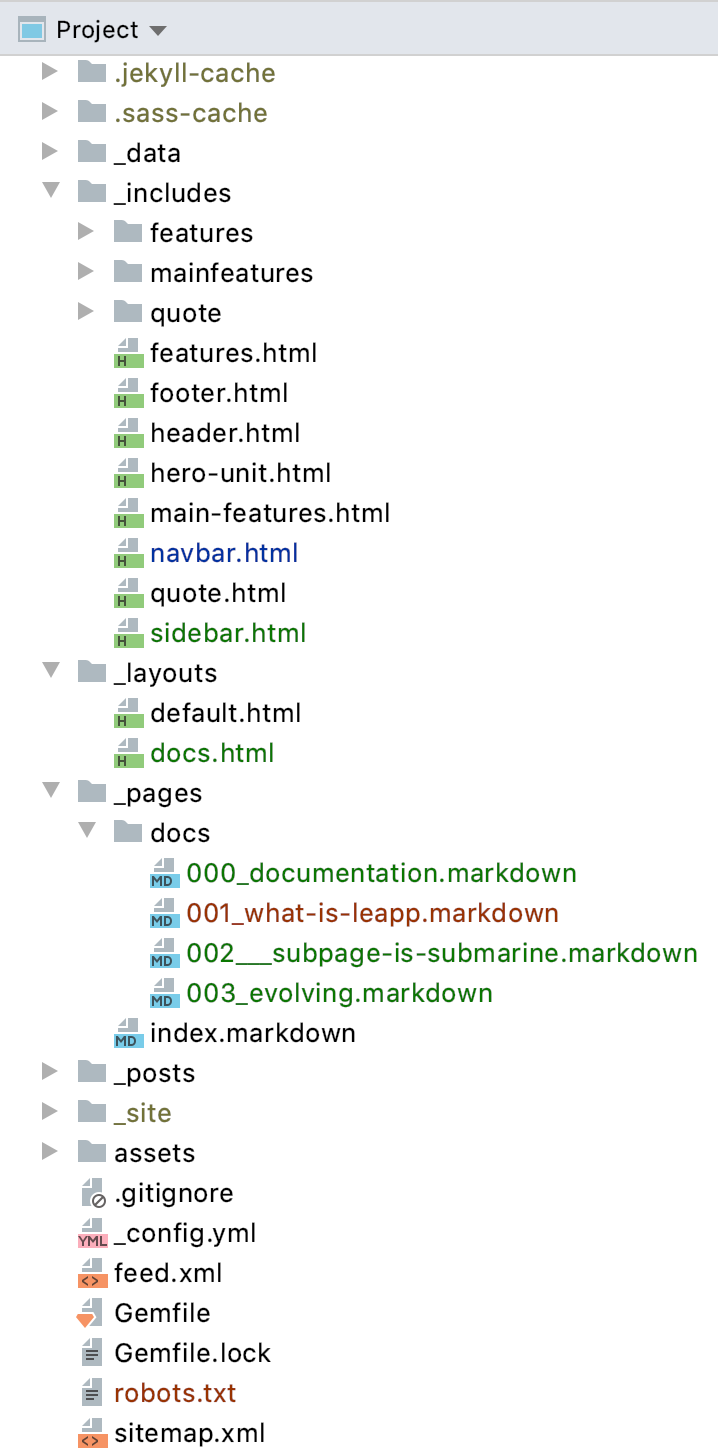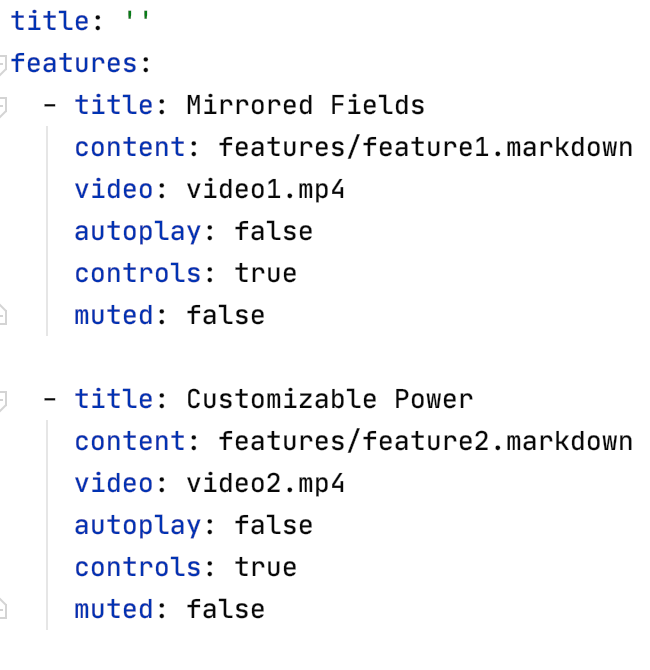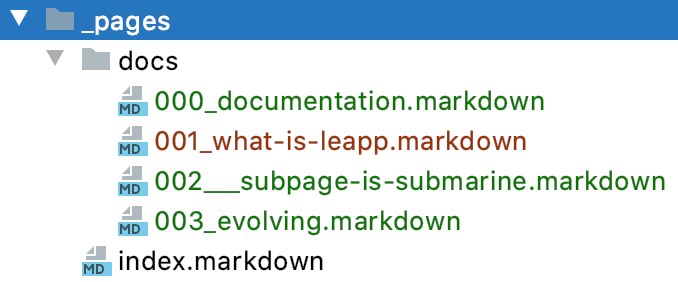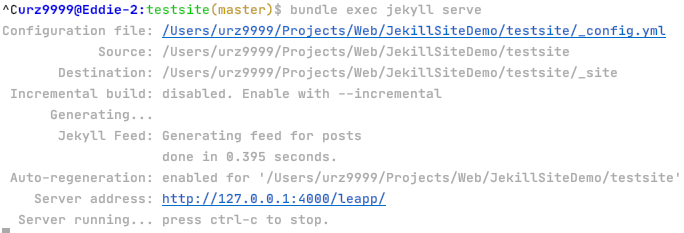Following is the documentation related to how this site works and how can you contribute to the documentation. You'll be guided in how to use Jekyll, on how to understand the project structure and finally how to add new material. Here's the table of content to make it easy to navigate this readme's sections.
Leapp's website is made in Jekyll, a simple yet powerful set of Ruby gems to create a dynamic website which can be staticised and put, as in our case, on GitHub Pages. The template is custom made to suit our needs and is created to allow easy contributions as there are only a few places where you need to make changes.
Let's see how the project's folder structure is defined:
Now you'll be guided through every folder to understand its purpose.
In this folder we put .yml files which contain data injected dynamically in the site pages to organize useful information and make it simple for developers and non-developers to adjust them on need. An example is given by the file features.yml which contains data to describe content inside the partial features.html inside _includes. You'll see later what a partial is and how it can be used.
As you can see the data is structured as a .yml file in which we have the page title and a set of features here, you can define every kind of variables that will be recovered and shown in the template we decide to include the file in.
Let's see it in this example:
<section id="features">
<div class="container">
<h2>{{site.data.features.title}}</h2>
<div class="features-holder">
{% for item in site.data.features.features %}
{% capture c %}{% cycle '', 'reverse' %}{% endcapture %}
<div class="feature {{c}}">
<div class="video">
<video {% if item.controls == true %}controls="controls"{% endif %} {% if item.autoplay == true %}autoplay="autoplay"{% endif %} {% if item.muted == true %}muted="muted"{% endif %} loop="loop"><source src="{{site.url}}{{site.baseurl}}/assets/videos/{{item.video}}" type="video/mp4" /></video>
</div>
<div class="content">
<h3>{{ item.title }}</h3>
{% capture p %}{% include {{item.content}} %}{% endcapture %}
{{ p | markdownify }}
</div>
<div class="clearfix"></div>
</div>
{% endfor %}
</div>
</div>
</section>Anyone can access and use variables and data from the .yml files in the *data folder using {{site.data.<NAME_*OF_FILE>.<NAME_OF_VARIABLE>}} like {{site.data.features.title}}. As you can see data is mixed with HTML to create microtemplates which can then be included in main pages.
In this folder you can see all the microtemplates used for organising code and make it simple to modify/maintain. These can be included in the main pages using the following syntax:
{% include navbar.html %}. Every microtemplate in the _include folder is used for pages in the _layouts folder. Let's see a simple example on how a microtemplate is done.
<nav>
<div class="container">
<div>
<img src="{{ site.url | absolute_url}}{{site.baseurl}}/assets/img/logo.png" alt="logo of Leapp" title="logo of Leapp" class="navbar-img" />
<h4>{{site.navbar_title}}</h4>
</div>
<ul>
<li><a title="Features" href="#features">Features</a></li>
<li><a title="Blog" href="{{site.blog_url}}">Blog</a></li>
<li><a title="Docs" href="/documentation">Docs</a></li>
<li><a title="Download" href="{{site.github_download_url}}">Download</a></li>
<li><a title="Twitter" href="{{site.twitter_url}}"><i class="fab fa-twitter"></i></a></li>
<li><a title="Facebook" href="{{site.facebook_url}}"><i class="fab fa-facebook"></i></a></li>
<li><a title="GitHub" href="{{site.github_url}}"><i class="fab fa-github"></i></a></li>
</ul>
</div>
</nav>Layouts are used to define how a page is shown in the site: they are linked to the markdown files in the _pages section of the project's structure. A layout can contain HTML and Liquid code to define both static and dynamic content. Here is a simple example of how the main page is defined:
<!DOCTYPE html>
<html>
{% include header.html %}
<body>
{% include tagmanagerscript.html %}
{% include navbar.html %}
{% include hero-unit.html %}
{% include main-features.html %}
{% include steps.html %}
{% include contributor.html %}
{% include footer.html %}
</body>
</html>You can see that we have described the entire page as a collection of microtemplates, each one pointing to a specific section of the page each with specific information contained both in the _include area and in the _data area.
Pages are the core of the structure as they present the end content. They are written in markdown and contains information about where the content will be presented as well as other important SEO information.
index.markdown is used a simple anchor to the main page as its content is managed via the _data subfolder as we have seen before.
---
title: Leapp - The definitive Credential Manager
description: Leapp - The best general purpose Credential generator in the world
permalink: /
layout: default
---It doesn't contains any markdown but 4 important properties you must know how to use:
- title: the title of the page presented in the address bar as well as in SEO meta.
- description: the description of the page in the SEO meta.
- permalink: defines the route of the page, that is very important as we have defined a custom directories' structure so you need to always specify the url in the permalink option.
- layout: define the layout you want to use to present your content.
Posts are not used at this very moment, but it will be used in the future. They are described with a name which follows this structure: . And contains the following properties:
---
layout: default
title: "Welcome to Jekyll!"
description: My awesome description
date: 2020-06-08 14:54:10 +0200
categories: jekyll update
---
- layout: which points to a possible new layout
- title: the title of the post (which is also used for SEO purposes)
- description: the description of the post (which is also used for both the excerpt of the page and for SEO purposes)
- date: 2020-06-08 14:54:10 +0200 follow this structure YYYY-MM-DD hh:mm:ss Z (the date of the post)
- categories: add some categories to the post
Then you can put your markdown content.
Is managed directly by Jekyll and contains the staticised site. Don't modify it as it changes directly reflecting your modifications.
Contains css, images, and any other media of the site we want to include in the pages. To include an assets you ave to use the following syntax to represent the url of the resource (you have to manually add resources to the folder too):
{{site.url | absolute_url}}{{site.baseurl}}/assets/<any-other-folder-if-present>/<name-of-the-file-with-extension>
Example:
<img src="{{site.url}}{{site.baseurl}}/assets/img/my_image.png" alt="my_image_alt" title="my_image_title" />
Our site supports both css and scss: in case you want to use scss you can take advantage of the partials directory inside css to store your sass in order to include them in the main.css
Contains some basic configurations to define some global site properties, like Twitter or Facebook accounts, global title and description and so on. You can normally see it and modify properties as you see fit. You can see the actual values of _config.yml here:
For enabling sass and css minification refer to these properties:
sass:
sass_dir: assets/css/partials
style: compressedYou can see the complete _config.yml structure ****here
Contributing for documentation can be done directly from GitHub like shown here: https://github.com/Noovolari/leapp/edit/master/_pages/docs/000_documentation.markdown. Generally speaking you can go directly to the site GitHub page: https://github.com/Noovolari/leapp
This is by far the simplest way to edit already existing documentation as you have direct access to it without installing anything.
This allows you to access every file directly from GitHub which is the simplest way to apply updates. However to make more advanced customization especially on specific pages of the sites the next session is clearly a more appropriate approach.
Every time you edit a file online or create a new one: a pull-request is prepared directly for you
- clone the project from our repository using software like https://www.sourcetreeapp.com/ or via Bash using this guide: https://docs.github.com/en/github/creating-cloning-and-archiving-repositories/cloning-a-repository or if you know it just using:
git clone [https://github.com/YOUR-USERNAME/YOUR-REPOSITORY](https://github.com/YOUR-USERNAME/YOUR-REPOSITORY)or if you have a copy of the project already you can use:git checkout masterin a folder of your choice which will contains the project. - Verify that you have at least ruby 2.6.3 installed on your machine. You can either install Ruby globally or via ruby env. to keep things cleaner, please use
ruby -vin your folder of choice to verify your Ruby version. If you don't have Ruby installed follow this guide: https://www.ruby-lang.org/it/documentation/installation/ which contains useful information on how to install it for different types of OS. For Mac users which is our main development platform we suggest using rbenv or RVM. - Once Ruby is installed and the project is cloned you can simply use your editor of choice and a terminal to make it work locally following these suggestions:
- Open the folder in your editor of choice, for example we suggest WebStorm from IntelliJ which gives autocompletion and a high level flexibility or Visual Studio Code for a more lightweight editor.
- Navigate to the project folder and either from the WebStorm terminal or your terminal run the following commands:
$ gem install bundler (if you don't have it already)
$ bundle install
$ bundle exec jekyll serveIf everything is ok you'll see something like this in your terminal at the end of all the operations:
As you can see the terminal is pointing you to a local IP address (127.0.0.1:4000/leapp/) which is used to show the site. Every time you make an update to the site, this is reflected here. Also the content of _site changes accordingly (as specified before, containing the built version of the site).
If for some reasons you don't see the update. Press CTRL+C in the terminal and then type bundle exec jekyll serve again to regenerate the site (the process is quite fast)
To do that you have to install the project locally as described in the previous step. By doing that you have complete controls on the files. Remember if you're adding a new markdown file for the documentation, refer to the naming convention to assure that it's position in the sidebar's menu is correct.
$ git add .
$ git commit -m "<ADD_YOUR_COMMIT_MESSAGE_HERE>" // use it to describe what you're update was about
$ git push origin masterSometimes using git online helper for making changes is not enough especially if you want to contribute to the site's structure and so on. for that is better to download the project locally by making a fork. Add your changes and then request a pull-request.
Access to your github and then navigate to our project url
- Fork the project by click the fork icon on the top right corner of the project page
- Now the project is forked on your repository and already cloned.
- Apply your modifications.
- Push the changes on your origin.
$ git add .
$ git commit -m "<ADD_YOUR_COMMIT_MESSAGE_HERE>" // use it to describe what you're update was about
$ git push origin master- Go to pull request tab in your project fork!
- Create a new pull request
-
You will see the changes proposed by your commit. You can also verify that the base repository is Noovolari/leapp and head repository is yours.
-
You just need to click create pull request:
- Insert details about your request and finalize creation.







